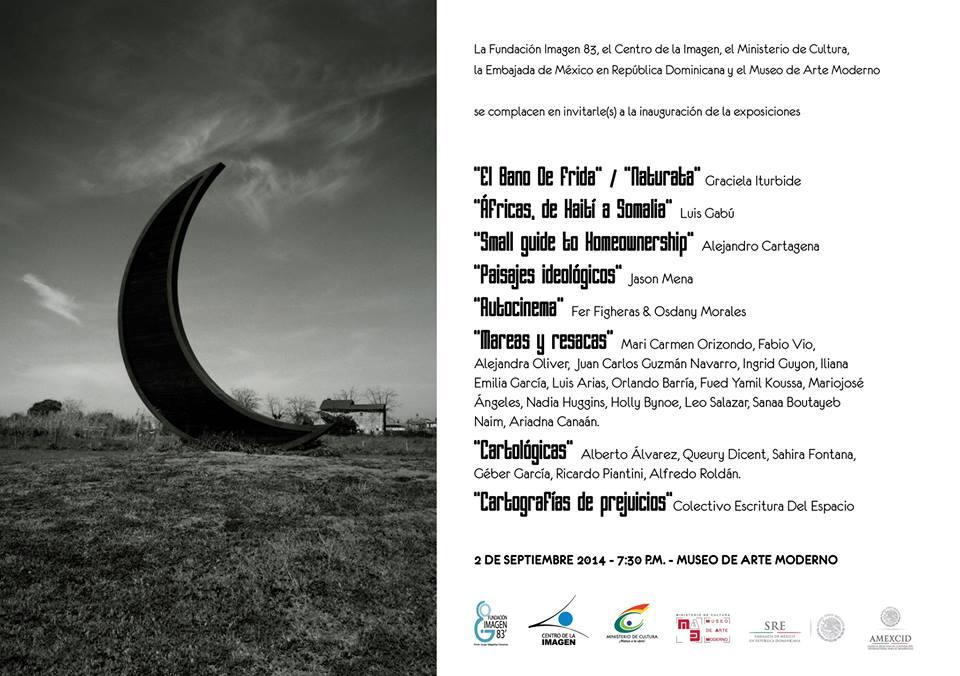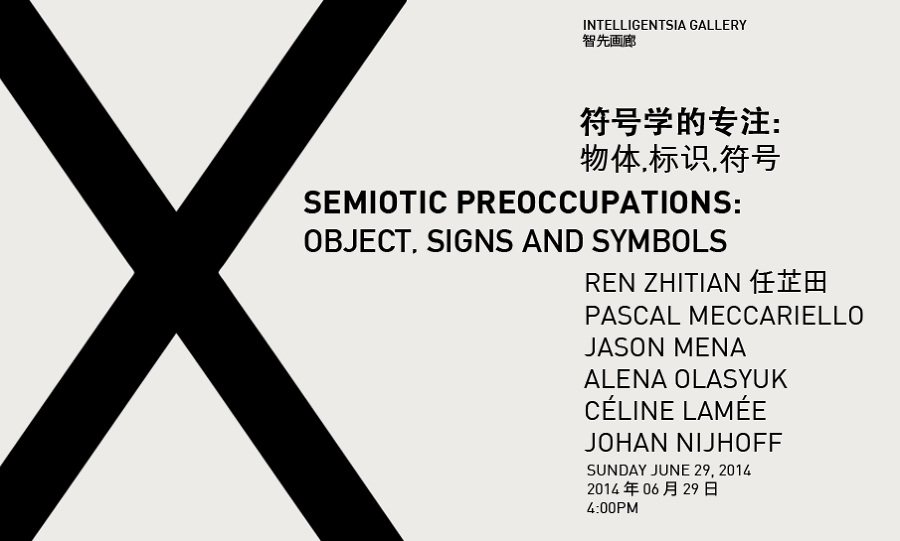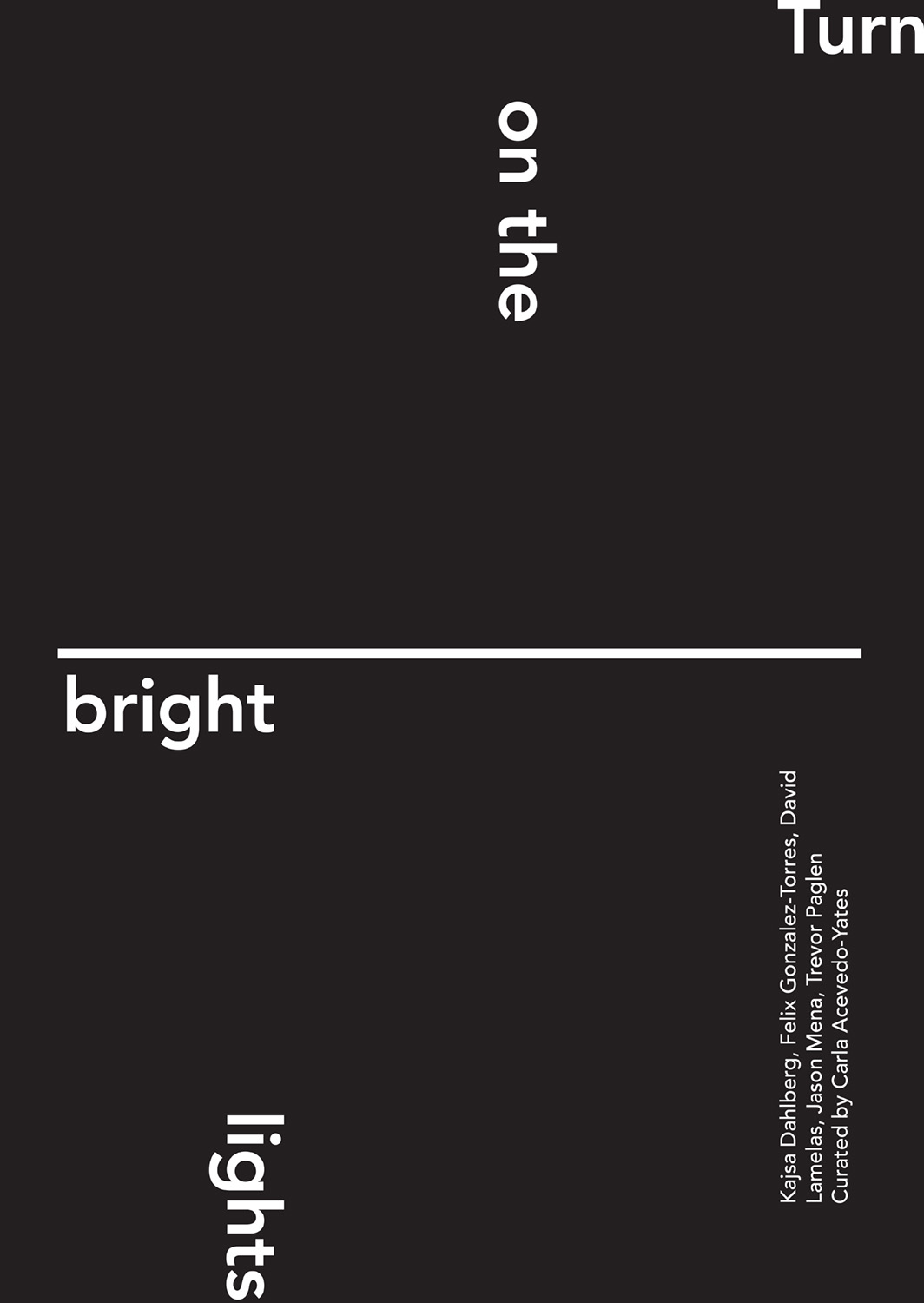2014

Bellos Jueves
4ta Edición
Jueves 30 de julio de 2014, 19:00 hs a 23:30 hs
Museo Nacional de Bellas Artes (MNBA)
Argentina
Bellos Jueves nació en abril de 2014 con el objetivo de entrecruzar el patrimonio del Museo Nacional de Bellas Artes con proyectos de artistas y músicos contemporáneos. El último jueves de cada mes entre las 19 y las 23.30 hs el MNBA abre sus puertas con intervenciones de artistas, música en las salas y terrazas, visitas rapeadas, videos y otras actividades.
Lejos de pensarse como una exhibición, este año el ciclo propone una serie de ensayos en relación a la museografía de la colección permanente y se piensa en vínculo con el numeroso público que visita cada edición. El carácter efímero de Bellos Jueves condiciona cada proyecto y desafía la temporalidad a la que están habituadas las artes visuales.
La importancia del ciclo reside en la invitación a artistas a pensar o problematizar a través de sus intereses y proyectos algún momento de la historia del arte, desde la colección del MNBA, interrumpiendo la linealidad con la que se presentan habitualmente las exhibiciones.
Esta edición de Bellos Jueves, desde las artes visuales, presenta los trabajos de Rosario Zorraquin y Sol Pipkin. Desde la propuesta musical se plantea un recorrido que atraviesa la performance audiovisual de Two Mirrors, la fusión entre rasgos de mu?sica patago?nica folclo?rica y el rock de Shaman, y una terraza con King Coya y la percusión digital de DJ Pato Smink.
Bellos Jueves cuenta con el apoyo Nacional Rock, Bodegas Emilia y Cerveza Schroll.
Programación:
19.00 (sala 19) Visita rapeada por Jhanna
19.00 (sala 3) “El nacimiento del paisaje en los Países Bajos del siglo XVI” a cargo del curador Ángel Navarro
19.30 (sala 29) Shaman Herrera
19.30 (sala 33) Visita a la sala permanente de Antonio Berni por el curador Roberto Amigo
19.30 (sala 11) Lectura del libro “El mes raro” de Valeria Meiller
20.00 (sala 19) Visita Rapeada por Jhanna
20.00 (sala 3) “El tamaño no importa: Bronzetti y paisaje” por Mabel Mayol
20.30 (pabellón) Visita a la exposición Tekoporá por Marcos Krämer
20.30 (sala 29) Two Mirrors
21.00 (sala 19) Visita Rapeada por Jhanna
21.00 “Rutas argentinas”: visita a la colección de fotografía del MNBA por Verónica Tell
21.30 Visita guiada a la sala de arte argentino de los años noventa por Natalia Pineau
21.30 (sala 11) Lectura del libro “El mes raro” de Valeria Meiller
21.30 (sala 29) Shaman Herrera
22.00 (terraza) DJ Pato Smink
22.30 (terraza) King Coya
Sala 2, 5, 10, 16
Rosario Zorraquin
Sala 32, 34, 35, 36
Sol Pipkin
Sala 24
Beatriz Santiago Muñoz
Sala 16
Jason Mena
Sala 16
Karlo Andrei Ibarra
Flickr
http://www.mnba.gob.ar/
Crossings
Casa Italia
Santo Domingo
Following his recent exhibition, "Paisajes ideológicos" [Ideological Landscapes], which opened at the Dominican Republic’s Museum of Modern Art on September 2, 2014, Puerto Rican artist Jason Mena now presents "Crossings." This show opens on September 5, 7:30 pm, at Casa Italia in Santo Domingo. This event is part of the PHOTOIMAGEN photography festival.
Every September the Dominican Republic celebrates photography month with a photography festival as an initiative of the Imagen 83 Foundation, Inc [Fundación Imagen 83] with the support of several private and public institutions. This major event is called PHOTOIMAGEN; it aims to encourage the advancement of contemporary photography and establish exchanges with international artists. This event’s general director is Mayra Johnson and its artistic director is Carlos Acero Ruiz.
Paisajes Ideológicos
2 de septiembre 2014 a las 7:30 P.M.
Museo de Arte Moderno (MAM)
Santo Domingo, República Dominicana
La muestra forma parte de Photoimagen 2014, festival de fotografía en República Dominicana, en su VI edición, con la participación de Graciela Iturbide (Mexico), Marcos López (Argentina), Colectivo MR (España), Quintapata: Jorge Pineda, Raquel Paiewonsky, Belkis Ramírez y Pascal Meccariello (República Dominicana), entre otros.
Museo de Arte Moderno de la República Dominicana
Avenida Pedro Henríquez Ureña,
Plaza de la Cultura Juan Pablo Duarte.
Tel: 809 685 2153 al 56 Ext. 222
Fax: 809 682 8280
Correo Electrónico: museo_de_arte_moderno@yahoo.com
Facebook: Museo de Arte Moderno (MAM) Rep. Dom.
http://centrodelaimagenrd.org/
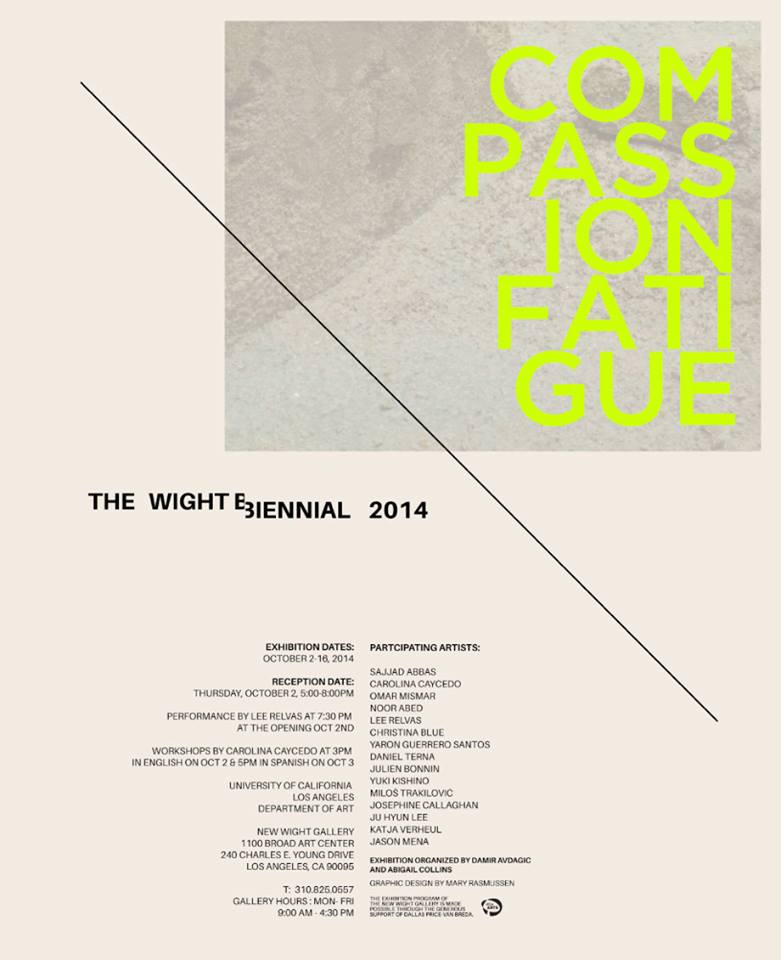
Compassion Fatigue
New Wight Biennial 2014
October 2 - 16, 2014
Opening Reception: Thursday, October 2, 5:00 - 8:00 pm
New Wight Gallery
University of California (UCLA)
Los Angeles, California
The UCLA New Wight Biennial, Compassion Fatigue, will present work from 16 international emerging artists using installation, performance, video, photography, and sound to enable intimate ways of viewing political crisis.
Artists: Sajjad Abbas, Carolina Caycedo, Jason Mena, Omar Mismar, Noor Abed, Curtis Grahauer, Lee Relvas, Christina Blue, Yaron Guerrero, Daniel Terna, Julien Bonnin, Yuki Kishino, Miloš Trakilovic, Josephine Callaghan, Ju Hyun Lee, Katja Verheul
Curated by UCLA Department of Art graduate students Damir Avdagic and Abigail Collins.
About the New Wight Biennial:
Founded in 1997 by professor and artist Mary Kelly, then chair of the UCLA Department of Art, the Wight Biennial is curated and produced by a committee of graduate students in the art department. The objective of the show is to exhibit this specific group of emerging artists as well as foster an investigative exchange between graduate programs at UCLA and other institutions.
New Wight Gallery
1100 Broad Art Center
Los Angeles, CA 90095
Directions to Broad Art Center
Gallery Hours:
Monday-Friday, 9:00am-4:30pm
For further information, call (310) 825-0557
To receive announcements about UCLA Department of Art exhibitions and events, please submit the form on our Contact page or visit us on Facebook.
The exhibition program of the New Wight Gallery is made possible by the generous support of Dallas Price-Van Breda.
Semiotic Preoccupations: Object, Signs and Symbols
Opening Sunday, June 29, 2014, 4:00 p.m.
June 29, 2014 – July 26, 2014
Intelligentsia Gallery
Beijing, China
Artists: Pascal Meccariello (Santo Domingo, Dominican Republic, 1968), Ren Zhitian (Xishui, China, 1968), Alena Olasyuk (Ukraine, 1988), Céline Lamée (Boxmeer, The Netherlands, 1980), Johan Nijhoff (Veenendaal, The Netherlands, 1979), Jason Mena (Puerto Rico, 1974).
Curated by Garcia Frankowski
The fifth international exhibition dissects the role and function of signs as vehicles of signification and meaning. Paintings, video, prints, and installations invite to scrutinize, review and question art as conveyor of symbols and as a signifying object in itself. Semiotic Preoccupations reveals the inexorable potential of a level of signification that is achieved by our inherent capacity to assimilate qualities, existential facts and conventions transforming them into possible readings of objects, signs, and symbols. In this flexible arena of ideas the most basic of forms could induce the most complex of meanings.
Curated by Garcia Frankowski, the exhibition feeds from the dialectical tension of artworks simultaneously specific in their material form and rizhomatic in the multiplicity of layers of their possible readings. Opening the 29th of June, Intelligentsia Gallery would present objects, signs and symbols in a search to answer our Semiotic Preoccupations.
Semiotic Elegy
Garcia Frankowski
What is the meaning of a word? Let us attack this question by asking first; what is an explanation of the meaning of a word? What does the explanation of a word look like?
-Ludwig Wittgentsein, The Blue Book, 1933-34
Semiotic
There is no world without an image of the world. Words, pictures, object are all devices that help us to create a mental image of our environment. For that which is concrete and visible, and also for the abstract and imaginary. While Wittgenstein’s aphorism the “limits of your language means the limits of your world” appears to be enough to explain how we come to understand things, we should not forget that language comes in all sorts of forms and mediums, from the spoken word to the moving image.
Preoccupations
This exhibition was born out of the necessity to address a semiotic preoccupation. How to present artworks that speak about the process through which we come to understand meaning? How to curate different mediums in the search of an image of the world that becomes only visible through objects signs and symbols? More specifically, how to present works that deal with the very specific desire to express that which cannot be expressed by any other means except the ones used? How to discuss questions about the ways we communicate ideas? How to present vehicles of inquiry? How to offer visual explanations of meaning?
Object
We start first with the material. Sign as object. Painted paper plates and cups. A ready-made table with painting and collages. Pascal Meccariello’s installation invites us to deconstruct the concept of Domesticity. The domestic, recalled by means of a painted ready-made table with patterns printed on the board, by the paper cups, bowls, and plates with collages and paint. Domesticity implies order and equilibrium, while all the elements evoke the action of a vertical construction. Here, the word (Domesticity) requires a second look. The process of questioning doesn’t start with the object, but with the word used to describe the object. Domesticity has multiple readings when understood with an emphasis on the second part of the word as if spelling it Domesti-City. The piling of plates, their collocation, their verticality, the fact that they are containers in the same manner that buildings contain space too, make the second reading a possibility. The installation is not anymore about a straightforward idea, but about the multiple readings of an object that acts both as sign and as symbol.
Is this Domesticity about ‘inhabitation’, or about the city? What do these plates communicate, especially after being stacked in such a composition? Is the work speaking about the life of objects, our life with objects, or objects as life?
Sign
Imagine that you would like to speak and words won’t come out. Your face articulates. Your mouth opens. Your eyes point fixedly in the direction where words will be projected. There will be coordination between your facial muscles, your sight, your mouth, but words won’t trigger your vocal cords. There is a constant struggle. You keep articulating, moving your facial muscles, your mouth opening and closing. Words just won’t come out. Without a doubt, there is no sound being emitted. But, would it be wrong to say that because you are lacking words there is no communication? Isn’t the artist, in his latent struggle, in his apparent fight to overcome tears of frustration, of exacerbating disappointment, communicating that very same struggle? Is there any way to speak other than what words can communicate?
Ren Zhitian’s video is a wordless Elegy. The lack of words, the effort, and the visual struggle compose a psychological paradox. Most is explained by the absence of the vehicle of communication. The message is carried by the lack of message, by the failure to communicate it.
His video of a Wordless Elegy is presented between two of his paintings. In fact between six of them. Machine-embroidered silk, painted with ink and fuel ash residue collected from garages across Beijing stand in stark contrast to the video. The untreated, the delicate strokes of ink and fuel, the shades of gray and black, reveal another story, and perhaps another struggle.
Elegant and Exhausted challenges ink painting as medium, and pattern as ornament. It signals a window that has been opened. And like his video work that displays the objectification of human emotion as sign, it converts the silk patterns, usually in the background, into the object of attention.
Symbol #1
In this show, Jason Mena presents a large scale letter “X”. Part of his “Absolute Value” series (a mathematical term, the “X” makes us ponder endless questions. The value of the “X” lies in the meaning—or lack— of it. The “X” has no meaning. “X” is the standard symbol used to represent the unknown. In Mathematics “X” is the constant variable. The value of “X” depends always on its immediate context. It resonates and it is altered by its environment. The “X” alters its meaning whenever it sits between words, numbers, or other symbols. We have to ask, in what language was it written? Greek? English? Mandarin? Should it imply something? Or is it just a visual provocation? Is it a symbol or a sign? Is it an object? If art is an expression, not of mere things or ideas, but of concrete experience with its values, what possible value can expression have when it becomes an end in itself? What happens when the “X” is presented next to a symbol of similar visual strength?
Symbol #2
Alena Olasyuk’s ink drawing is the third part of a tryptique of large scale ink drawings. By stripping the piece of its usual context a new dialectic is created. The "O" is nto longer a third step, but a symbol on its own. What at first glance seemed obvious when compared to the other three pieces acquires new possible readings when presented in the context of this exhibition.
Usually labor-intensive, the “O” is perhaps the first time that Olaskyuk’s work frees itself from the specificity of the small detail and adventures into the unknown terrain of the generic. The circle, omnipresent through the history of pictorial representation wanders in the realm of the unanswered. Both sign, and symbol, the “O” is both mysterious and sublime. And although it may raise more questions than answers, it evidences our search for satisfying the human need to express ideas, feelings, and emotions through images.
Symbol #3
While some symbols whose specificity summons infinite arrays of possible meanings, there is an equally endless amount of symbols that can be used to reference very specific concepts. In other words, while an “X” or an “O” can pose unanswerable questions, very specific (up to a certain point) concepts like female and male can be portrayed in almost infinite variations. Celine Lamee and Johan Nijhoff create a work that mixes serious historic research and humour presenting a series of variations of gender pictograms. Each of the fifty-four pictograms reveals simultaneously the possibilities and potentialities. Possibility in the sense that every simple idea could have a least one icon to describe it. And potentialities when it displays how even the most simple of concepts can motivate the creation of endless ways to represent them.
Intelligentsia Gallery
Dong Wang Hutong #11
Dong Cheng District
Beijing, China
Tel. +86 183 1075 4745
intelligentsia.gallery@gmail.com
http://intelligentsiagallery.com/
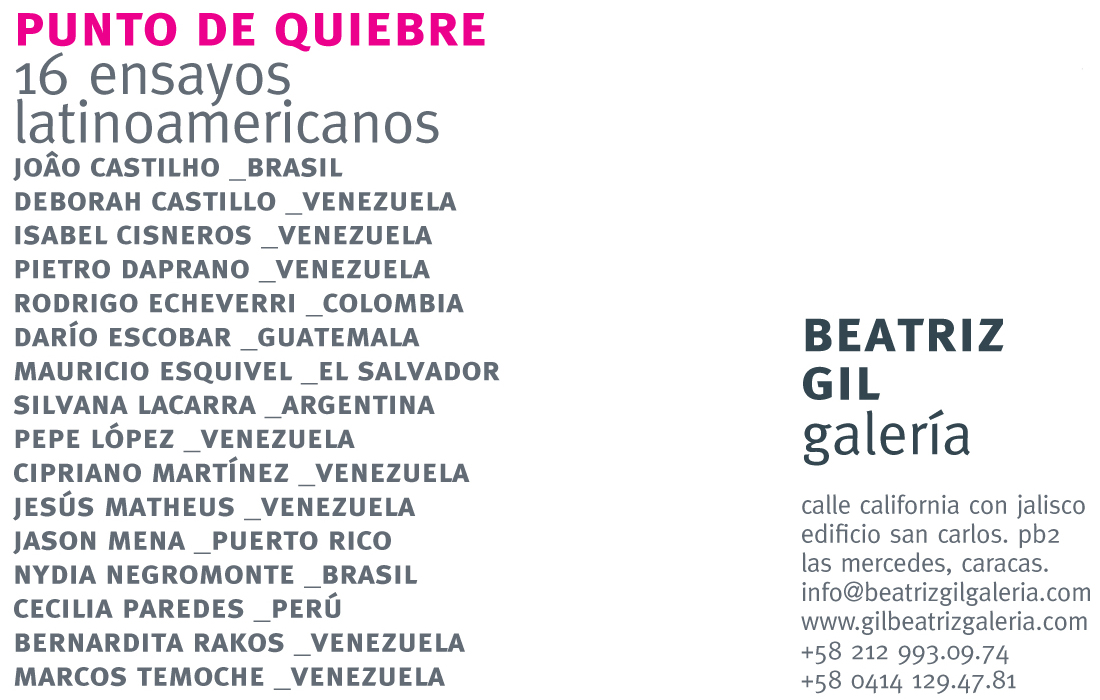
Punto de Quiebre: 16 ensayos latinoamericanos
Curaduría: Lorena González I.
26 de junio - 1 de septiembre de 2014
Beatriz Gil Galería
Venezuela
Artistas:
Joâo Castilho (Brasil)
Deborah Castillo (Venezuela)
Isabel Cisneros (Venezuela)
Pietro Daprano (Venezuela)
Rodrigo Echeverri (Colombia)
Darío Escobar (Guatemala)
Mauricio Esquivel ( El Salvador)
Silvana Lacarra (Argentina)
Pepe López (Venezuela)
Cipriano Martínez (Venezuela)
Jesús Matheus (Venezuela)
Jason Mena (Puerto Rico)
Nydia Negromonte (Brasil)
Cecilia Paredes (Perú)
Bernardita Rakos (Venezuela)
Marcos Temoche (Venezuela)
Asistente curatorial: Miguel Rodríguez Sepúlveda (México)
Museografía: Pietro Daprano
Proyecto gráfico: Teresa Mulet
Producción General: Beatriz Gil Galería
El siglo XXI se ha caracterizado por trazar una nueva geografía en el desempeño actual del arte contemporáneo. Dos ejes de acción, relativos y paralelos han dinamizado un complejo nudo de enlaces, novedades, descubrimientos y fluctuaciones: al alimón de las descollantes aperturas que la tecnología y el mundo web 2.0 ofertaron para todos los participantes de la cultura global se inició un ciclo donde el debate abierto comenzó a revelar nuevas zonas sombrías dentro de esas “supuestas verdades” compartidas por todos. Luego de una antesala plena de rupturas, de postulados teóricos, de conjeturas albergadas en el ejercicio humano y social de la escalada triunfal de la cyber-democracia, la nueva era sembró el desconsuelo de estridentes imposibilidades de conexión: guerras, desmanes, una miseria generalizada y un funesto desarrollo de neo-fundamentalismos reciclados que ya han devastado las lejanas esperanzas del progreso.
Sin embargo, la posibilidad individual ha surgido con empeño en medio de la crisis y el caos mundial que nos envuelve. Desde ese punto de quiebre que transformó las relaciones de lo particular con el entorno entre finales del siglo XX y los inicios del XXI, también se han develado nuevas estrategias de acción: eslabones donde el documento, la memoria, el testimonio y las diversas formas de asentar la fugacidad de la experiencia privada y colectiva anclan el poder de un individuo que ya no observa lugares soñados a dónde debe llegar para ser alguien, o inaccesibles utopías impuestas por otros que deben ser alcanzadas para encontrar algo. Ahora, más que nunca, las ilusiones particulares saben que es solo desde el constructo crítico de sus propias fronteras y desde su capacidad para aglutinar las voluntades que le rodean, el sitio real donde pueden y podrán consolidar un mejor lugar para sí mismo y para los otros.
En este sentido, las perspectivas del arte en general y muy especialmente del arte latinoamericano han transformado una buena parte de sus inquietudes, desviando esa área inicial insertada en la necesidad de colocar el propio discurso dentro de los movimientos legitimadores de la cultura foránea hacia una mirada interior mucho más plural, zona refractada de un arte que se levanta en el punto de quiebre de estas antiguas prácticas territoriales para presentarse como la reedición de una nueva sensibilidad, ahora focalizada en los propios problemas formales, conceptuales, políticos y sociales de los creadores, sin dejar de ser áreas de contenido capaces de albergar un carácter mundial-global.
Este ejercicio entra en conexión directa con varias de las pautas teóricas que para el arte actual ha introducido el crítico Nicolas Bourriaud quien se apropió del vocablo post-producción con la finalidad de concertar las señales de esa ebullición creativa distintiva de nuestro tiempo: empalmes donde la materia manipulada por el artista ha dejado de ser «materia prima» para elaborar «formas» a partir de productos culturales «in-formados» por otros; derivaciones artísticas donde el arte ya no es el aspaviento inédito heredado de la modernidad o la obra única capaz de sostener la verdad y la esencia de un lenguaje oculto. Ahora, son obras a partir de obras, productos de consumo, retazos culturales, trozos de film, objetos varios, material web, sonidos reeditados, estereotipos, reciclaje y apropiación, algunas de las destrezas y mecanismos que determinan el arte más reciente. La consecución de los procesos ya no guarda relación con las famosas rupturas formales de la vanguardia de turno o la necesidad latinoamericana de reinsertarse en las líneas de acción de este perímetro hegemónico. El acontecer que la globalización y la era de internet le han conferido a las relaciones entre autor, medios, lugares de difusión, obra y receptor, ha encaminado los procesos hacia la ilación de retazos donde la memoria, el fragmento, la historia individual y la metáfora serán las claves para una obra que más que asentamiento de verdades es discurso en proceso, periplo del sí mismo, puesta en escena de todas las inquietudes que ese sujeto artístico está tratando de convocar y transmitir.
En Punto de quiebre hemos querido medir y poner en relación las propuestas visuales de dieciséis artistas de generaciones distintas y de contextos latinoamericanos diversos (algunos residentes en países diferentes a su lugar de origen) que se insertan en el desarrollo de estas aristas tan características de nuestra contemporaneidad. A través de tácticas diversas y con la expectativa única de responder y preguntar a través del arte, revisitan y escamotean lugares donde la fotografía, la pintura, el dibujo, la performance, el collage, el video, la instalación y la escultura se enlazan como las bases de una acción en plena resonancia con los tránsitos vitales del contexto y la experiencia particular del yo dentro de los vaivenes virtuales y las huellas materiales del ser social. La investigación se inició sin temas específicos, pero poco a poco, en los intercambios desarrollados durante varios meses, miles de zonas en comunión vinieron a correr la cortina de ese lugar central que le dio el título a la muestra; Punto de quiebre, ruptura con las formas y los medios tradicionales de ejecución formal y conceptual que vienen a levantar una sucesión de crónicas visuales cercanas entre sí: desde los gestos efímeros, la permanencia de lo visual y las alegorías trashumantes de una presencia humana a contrapunto de la imagen (Joâo Castilho, Bernardita Rakos, Isabel Cisneros, Mauricio Esquivel); en las resonancias de un presente que reposiciona la historiografía latinoamericana, generando disposiciones fracturadas, residuos ancestrales y compendios críticos de una gran fuerza visual (Jesús Matheus, Silvana Lacarra, Darío Escobar, Cipriano Martínez); en los vínculos de la presencia, la acción del cuerpo físico y su relación con los elementos como foco que reinstala el ciclo vital de una memoria subterránea desprendida desde la referencia local hacia los vericuetos de la memoria colectiva (Nydia Negromonte, Cecilia Paredes, Pietro Daprano, Pepe López); hasta las señales de lo urbano, los olvidos de la historia oficial y sus contradicciones, así como las prácticas, movimientos y manipulaciones de un poder transfigurado y suscrito por relaciones ocultas y golpes ambivalentes en el día a día del ciudadano común (Jason Mena, Rodrigo Echeverri, Déborah Castillo y Marcos Temoche).
En Punto de quiebre todos los artistas dispusieron sus proyectos como una jugada verbal, un enunciado iconográfico alrededor de las distintas temáticas generales que los agrupan y que también podrían conectarlos transversalmente. Es por ello que se ha usado la figura del “ensayo” como núcleo central de descripción y reunión de los distintos entramados formales que cada uno ha aplicado para este primer encuentro; una apuesta curatorial que también funciona como un proceso abierto en el diálogo sostenido con ellos y que en ambos casos trabaja como un campo de investigación compartido, dando como resultado una cartografía amplia, plena de evidencias e incertidumbres, de discursos visuales transitivos, de engranajes implícitos y elementos fugaces que van tras esa imagen plural que está intentando narrar y narrarse frente a las fracturas individuales y colectivas- que inundan las mudables verdades de nuestra cultura contemporánea.
Lorena González I.
http://www.beatrizgilgaleria.com/
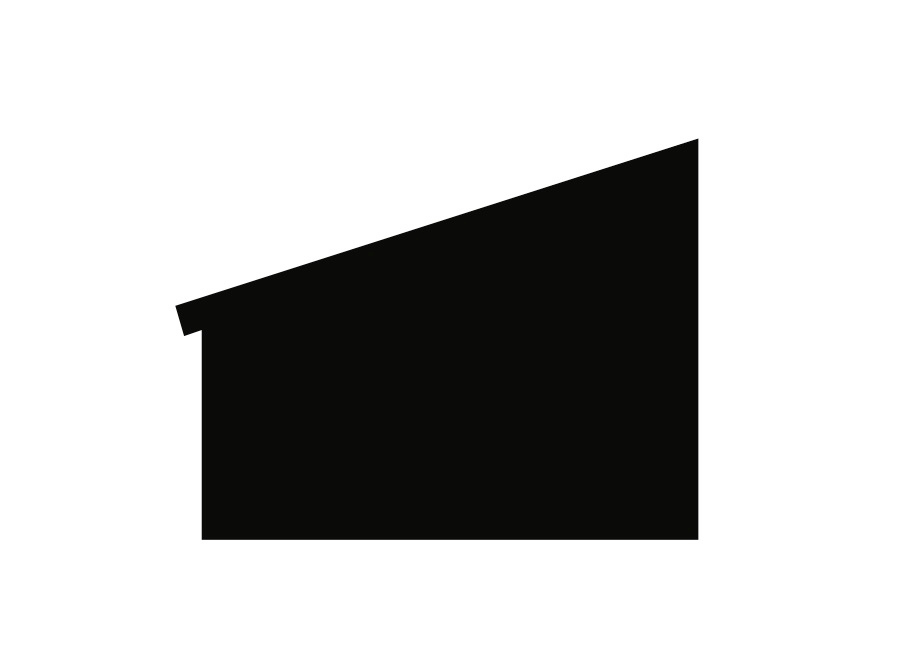
Panel Discussion & Various Formats Are Appropriate
Sunday, May 25, 2014, 5 - 8 pm
Silvershed
New York
Artists: Daisy Atterbury, James Kelly, Jason Mena, Matthew Schrader, Ezra Tessler, Johanna Tiedtke, Kyle Zynda
How to Proceed:
1. Identify, or help participants identify, an issue or topic that involves an important conflict in values and/or an examination of complicity. The issue or topic may be set forth as a topical question, a hypothetical incident, a case study or a projection of fantasy.
2. Select panelists who are well informed about and have specific points of view regarding the issue or topic. Select a leader or moderator. Select a form of affective labor. A panel discussion that includes three to five panelists is usually most workable.
3. Indicate to the panelists the objectives the panel discussion is designed to promote and allow time for panelists to prepare for the discussion. In some situations, ten or fifteen minutes may be sufficient time for preparation while in other situations, panelists may need to prepare several weeks in advance of the scheduled discussion.
4. Decide upon the format the panel discussion will follow. Various formats are appropriate.
Silvershed is an artist-run project space in Chelsea that works collaboratively between New York and Los Angeles and organizes exhibitions, events, and special projects by or with other artists. Exploring the increasingly lateral flow of information, ideas, and resources, we aim to generate discussions about contemporary art values, ethics, and aesthetics.
Established in 2008 by Patrick Meagher, Yunhee Min, and Oliver Lanz, Silvershed works through lateral discussion among a core team of organizers and advisors: Alexander Dawson, Kerry Hassler, Emily Lenz, Pat Lian, Nicolas Linnert, Patrick Meagher, Yunhee Min, Melinda Wang
Silvershed
119 West 25th St, PH
New York, NY 10001
info@thesilvershed.org
Turn on the bright lights
Opening Reception: Sunday, April 13, 2014, 1pm - 4pm
April 13 - May 25, 2014
Center for Curatorial Studies (CCS)
Bard College
Hessel Museum of Art
New York
Artists: Kajsa Dahlberg, Felix Gonzalez-Torres, David Lamelas, Jason Mena, Trevor Paglen
Curated by Carla Acevedo-Yates
Depending on how bright it is, a light in the dark can either help us see or completely blind us. And if darkness is conventionally understood to obscure vision, it also makes manifest spaces that cannot otherwise be represented. Drawing on these contradictions in the intricacies of seeing and not seeing, Turn on the bright lights examines how artists use abstraction as a conceptual device to materialize that which remains elusive, indeterminate, and invisible. The exhibition has two parts, emphasizing first an embodied experience of forms, where sculpture, photography, video, and painting speak to the complexities of seeing counter-spaces. It then leads to an increasingly dematerialized environment in which the perceptual limits of meaning are themselves rendered opaque, difficult, and abstract.
Abstraction in the visual arts has often been understood through the lens of the historical avant-garde and high modernism, whose utopian ideals of universality and humanism were intertwined with the totalizing ambitions of the social and political projects of Western modernity. By contrast, the artists in this exhibition deploy abstractions—such as indeterminate geographies, image negation, and the monochrome—as a formal strategy for advancing a nuanced understanding of power relations, a strategy of localized resistance.
Propositions for an Abstract Region
Abstract regions are complex spatializations that are socially and politically produced.
Abstract regions are everywhere. They operate as spaces of resistance, catalyzing collective possibilities, but also construct their own oppressive power structures.
Geographies are irreducible to cartographic representations.
Depending on our subjective position, we see what we are allowed to see.
The boundary line has extended. The fault line has collapsed.
The invisible has arisen as a cautionary tale. The visible obstructs our vision. We are only left with traces of the real.
The politics of visibility operate everywhere, every day, on everyone.
Our senses have been compromised.
Free chartered bus to and from New York City for the opening.
For reservations, call 845.758.7598, or write ccs@bard.edu
Suprema Felicidad
Curaduría: Brenda Caro
Del 30 de enero hasta el 27 de abril de 2014
Casa del Lago
Sala 5
Ciudad Mexico
Esta exposición colectiva reúne el trabajo de artistas que centran su atención sobre una serie de discursos que acompañan a una noción tan escurridiza como la de bienestar y las políticas de la felicidad que están en su base. Si el progreso y la utopía se han propuesto en algún momento como respuesta, si se es capaz de minimizar la desigualdad y la precariedad bajo la afirmación de que pese a todo somos felices, ¿por qué ese "estar bien" nos sabe tan agridulce?
Artistas: Edgardo Aragón, Katrina Bello, Eder Castillo, Emilio Chapela, Omar Gámez, Terence Gower, Jason Mena, Chantal Peñalosa, Sebastián Romo, Pilar Villela, Víctor Sánchez.
